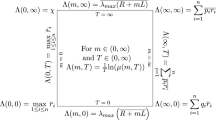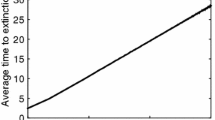Abstract
Dispersal-induced growth (DIG) occurs when several populations with time-varying growth rates, each of which, when isolated, would become extinct, are able to persist and grow exponentially when dispersal among the populations is present. This work provides a mathematical exploration of this surprising phenomenon, in the context of a deterministic model with periodic variation of growth rates, and characterizes the factors which are important in generating the DIG effect, and the corresponding conditions on the parameters involved.





Similar content being viewed by others
References
Abbott KC (2011) A dispersal-induced paradox: synchrony and stability in stochastic metapopulations. Ecol Lett 14:1158–1169. https://doi.org/10.1111/j.1461-0248.2011.01670.x
Allen LJ, Bolker BM, Lou Y, Nevai AL (2007) Asymptotic profiles of the steady states for an SIS epidemic patch model. SIAM J Appl Math 67:1283–1309. https://doi.org/10.1137/060672522
Baguette M, Benton TG, Bullock JM (2012) Dispersal ecology and evolution. Oxford University Press, Oxford
Bansaye V, Lambert A (2013) New approaches to source-sink metapopulations decoupling demography and dispersal. Theor Popul Biol 88:31–46. https://doi.org/10.1016/j.tpb.2013.06.003
Bascompte J, Possingham H, Roughgarden J (2002) Patchy populations in stochastic environments: critical number of patches for persistence. Am Nat 159:128–137. https://doi.org/10.1086/324793
Benaïm M, Lobry C, Sari T, Strickler E (2021) Untangling the role of temporal and spatial variations in persistance of populations. arXiv preprint arXiv:2111.12633
Bhatia R (1997) Matrix analysis. Springer, New-York
Chen S, Shi J, Shuai Z, Wu Y (2022) Two novel proofs of spectral monotonicity of perturbed essentially nonnegative matrices with applications in population dynamics. SIAM J Appl Math 82:654–676. https://doi.org/10.1137/20M1345220
Cheong KH, Koh JM, Jones MC (2019) Paradoxical survival: examining the Parrondo effect across biology. BioEssays 41:1900027. https://doi.org/10.1002/bies.201900027
Chicone C (2006) Ordinary differential equations with applications. Springer, New-York
Cousens R, Dytham C, Law R (2008) Dispersal in plants: a population perspective. Oxford University Press, Oxford
Dias PC (1996) Sources and sinks in population biology. TREE 11:326–330. https://doi.org/10.1016/0169-5347(96)10037-9
Evans SN, Ralph PL, Schreiber SJ, Sen A (2013) Stochastic population growth in spatially heterogeneous environments. J Math Biol 66:423–476. https://doi.org/10.1007/s00285-012-0514-0
Guiver A, Packman D, Townley S (2017) A necessary condition for dispersal driven growth of populations with discrete patch dynamics. J Theor Biol 424:11–25. https://doi.org/10.1016/j.jtbi.2017.03.030
Hale JK (2009) Ordinary differential equations. Dover, New-York
Hanski IA, Gaggiotti OE (eds) (2004) Ecology, genetics and evolution of metapopulations. Elsevier Academic Press, San Diego
Hirsch MW, Smith H (2006) Monotone dynamical systems. In: Drábek P, Fonda A (eds) Handbook of differential equations: ordinary differential equations 2. Elsevier, Amsterdam
Hudson PJ, Cattadori IM (1999) The Moran effect: a cause of population synchrony. TREE 14:1–2. https://doi.org/10.1016/S0169-5347(98)01498-0
Jansen VA, Yoshimura J (1998) Populations can persist in an environment consisting of sink habitats only. PNAS 95:3696–3698. https://doi.org/10.1073/pnas.95.7.3696
Kawecki TJ (2004) Ecological and evolutionary consequences of source-sink population dynamics. In: Hanski IA, Gaggiotti OE (eds) Ecology, genetics and evolution of metapopulations. Elsevier Academic Press, San Diego, pp 387–414
Klausmeier CA (2008) Floquet theory: a useful tool for understanding nonequilibrium dynamics. Theor Ecol 1:153–161. https://doi.org/10.1007/s12080-008-0016-2
Kortessis N, Simon MW, Barfield M, Glass GE, Singer BH, Holt RD (2020) The interplay of movement and spatiotemporal variation in transmission degrades pandemic control. PNAS 117:30104–30106. https://doi.org/10.1073/pnas.2018286117
Krantz SG, Parks HR (2002) The implicit function theorem: history, theory, and applications. Springer, New-York
Lewis MA, Petrovskii SV, Potts JR (2016) The mathematics behind biological invasions. Springer, New-York
Liu S, Lou Y (2022) Classifying the level set of principal eigenvalue for time-periodic parabolic operators and applications. J Funct Anal 282:109338. https://doi.org/10.1016/j.jfa.2021.109338
Liu S, Lou Y, Peng R, Zhou M (2022) Monotonicity of the principal eigenvalue for a linear time-periodic parabolic operator. Proc Am Math Soc 147:5291–5302. https://doi.org/10.1090/proc/14653
Liu S, Lou Y, Song P (2022) A new monotonicity for principal eigenvalues with applications to time-periodic patch models. SIAM J Appl Math 82:576–601. https://doi.org/10.1137/20M1320973
Lobry C (2022) Entry-exit in the halo of a slow semi-stable curve. arXiv preprint arXiv:2203.10357
Matthews DP, Gonzalez A (2007) The inflationary effects of environmental fluctuations ensure the persistence of sink metapopulations. Ecology 88:2848–2856. https://doi.org/10.1890/06-1107.1
Metz JAJ, De Jong TJ, Klinkhamer PGL (1983) What are the advantages of dispersing; a paper by Kuno explained and extended. Oecologia 57:166–169. https://doi.org/10.1007/BF00379576
Morita S, Yoshimura J (2012) Analytical solution of metapopulation dynamics in a stochastic environment. Phys Rev E 86:045102. https://doi.org/10.1103/PhysRevE.86.045102
Perthame B (2007) Transport equations in biology. Birkhäuser Verlag, Basel
Pulliam HR (1988) Sources, sinks, and population regulation. Am Nat 132:652–661. https://doi.org/10.1086/284880
Roy M, Holt RD, Barfield M (2005) Temporal autocorrelation can enhance the persistence and abundance of metapopulations comprised of coupled sinks. Am Nat 166:246–261. https://doi.org/10.1086/431286
Rudin W (1976) Principles of mathematical analysis. McGraw-hill, New-York
Schreiber SJ (2010) Interactive effects of temporal correlations, spatial heterogeneity and dispersal on population persistence. Proc R Soc B Biol Sci 277:1907–1914. https://doi.org/10.1098/rspb.2009.2006
Su YH, Li WT, Lou Y, Yang FY (2020) The generalised principal eigenvalue of time-periodic nonlocal dispersal operators and applications. J Differ Equ 269:4960–4997. https://doi.org/10.1016/j.jde.2020.03.046
White ER, Hastings A (2020) Seasonality in ecology: progress and prospects in theory. Ecol Complex 44:100867. https://doi.org/10.1016/j.ecocom.2020.100867
Williams PD, Hastings A (2011) Paradoxical persistence through mixed-system dynamics: towards a unified perspective of reversal behaviours in evolutionary ecology. Proc R Soc B Biol Sci 278:1281–1290. https://doi.org/10.1098/rspb.2010.2074
Acknowledgements
I am grateful to the referees for comments and references which have led to significant improvement of the manuscript.
Author information
Authors and Affiliations
Corresponding author
Additional information
Publisher's Note
Springer Nature remains neutral with regard to jurisdictional claims in published maps and institutional affiliations.
Rights and permissions
Springer Nature or its licensor holds exclusive rights to this article under a publishing agreement with the author(s) or other rightsholder(s); author self-archiving of the accepted manuscript version of this article is solely governed by the terms of such publishing agreement and applicable law.
About this article
Cite this article
Katriel, G. Dispersal-induced growth in a time-periodic environment. J. Math. Biol. 85, 24 (2022). https://doi.org/10.1007/s00285-022-01791-7
Received:
Revised:
Accepted:
Published:
DOI: https://doi.org/10.1007/s00285-022-01791-7




